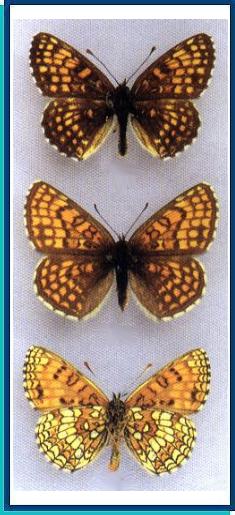LEPIDOPTERA
N Y M P H A L I D A E Swainson, 1827
MELLICTA Billberg, 1820
Mellicta athalia (Rottemburg, 1775)
Mellicta athalia (Rottemburg, 1775)

• TYPE LOCALITY. «Umgebung Paris» [Environs of Paris, France].
• RANGE- From N. and central Europe across temperate Asia to the Amur region and Kamchatka Peninsula.
• DISTRIBUTION AND VARIATION. An extremely variable species which seems highly sensitive to ecological conditions. Along with the nominotypical subspecies, which occurs in the central and S. European parts, the Caucasus and Transcaucasia, and W. Siberia, the following forms can be regarded as subspecies over the territories concerned: ssp. norvegica Aurivillius. 1888 - N. European part, Fennoscandia; ssp. dictynnoides Hormuzaki, 1898 - SW. European part; ssp. lucifuga Fruhstorfer, 1917 - SE. European part; ssp. reticulata Higgins, 1955 - Altais; ssp. baikalensis Bremer, 1861 (?= tinica Fruhstorfer, 1910)- S. Siberia to the ?Amur region; ssp. hyperborea Dubatolov, 1997 - NE. Far East (Magadan Region and Kamchatka). However, one must keep in mind that their precise distribution patterns still remain uncertain (see below)
• TAXONOMIC NOTES. As stated by Higgins (1955), it is difficult to attribute with certainty the name dictynnoides either to athalia or aurelia, or britomartis, as the data by Hormuzaki are not sufficient; a replacement name, diciminoides Verity, 1940, is available if necessary. The taxon asiae Verity, 1940, described from the S. Ussuri region (Suchan), seems to be based on an incorrectly labeled material (Higgins, 1955); so it is disregarded herein since the occurrence of M. cithalici in the S. Ussuri region has since never been reconfirmed. Taking into account the high variability of M. athalia, it cannot be excluded that all the above subspecies may prove to merely represent ecological rather than geographical forms. On the other hand, some more or less "true" subspecies (like reticulata may turn out to be distinct species, if their suspected sympatry with the nominotypical M. athalia has been confirmed. Solution of the problem depends on further research in the distribution and biological features of the known forms of the species. Concerning baikalensis, see "TAXONOMIC NOTES" under Melitaea arcesia.
• HABITATS AND BIOLOGY. A variety of grassy, flowering habitats ranging from damp forest edges and clearings in the forest and forest steppe belts to dry open slopes in the mountains. Flight period: end of May to August, depending on local conditions, usually in a single generation, but a partial second generation has sometimes been reported. Host plants (Higgins, 1955, after Urbahn, 1952; Korshunov & Gorbunov, 1995: Tolman, 1997): Plantago, Veronica, Melampyrum, Digitalis, Linaria, Centawea, Chrysanthemum, Hieracium, Tanacetum. Hibernation larval (Kumakov & Korshunov, 1979). Egg-laying in large groups of 50 or more. Early instar larvae live in a web nest which changes its shape as the host plant is eaten. After wintering, they escape from a slot and crawl out one by one.
• SIMILAR SPECIES. Mellicta ambigua: ground colour of UPS more bright yellow; UNS duller, pale pattern yellowish. M. caucasogenita: smaller, UPH almost entirely suffused with black. M. britomartis: ground colour of UPS generally darker, suffused with black; UNH postdiscal fascia usually shaded dark, double terminal line brownish; genitalia different.
Photo and text: Guide to the BUTTERFLIES OF RUSSIA and adjacent territories Volume 2. PENSOFT, Sofia - Moscow. 2000